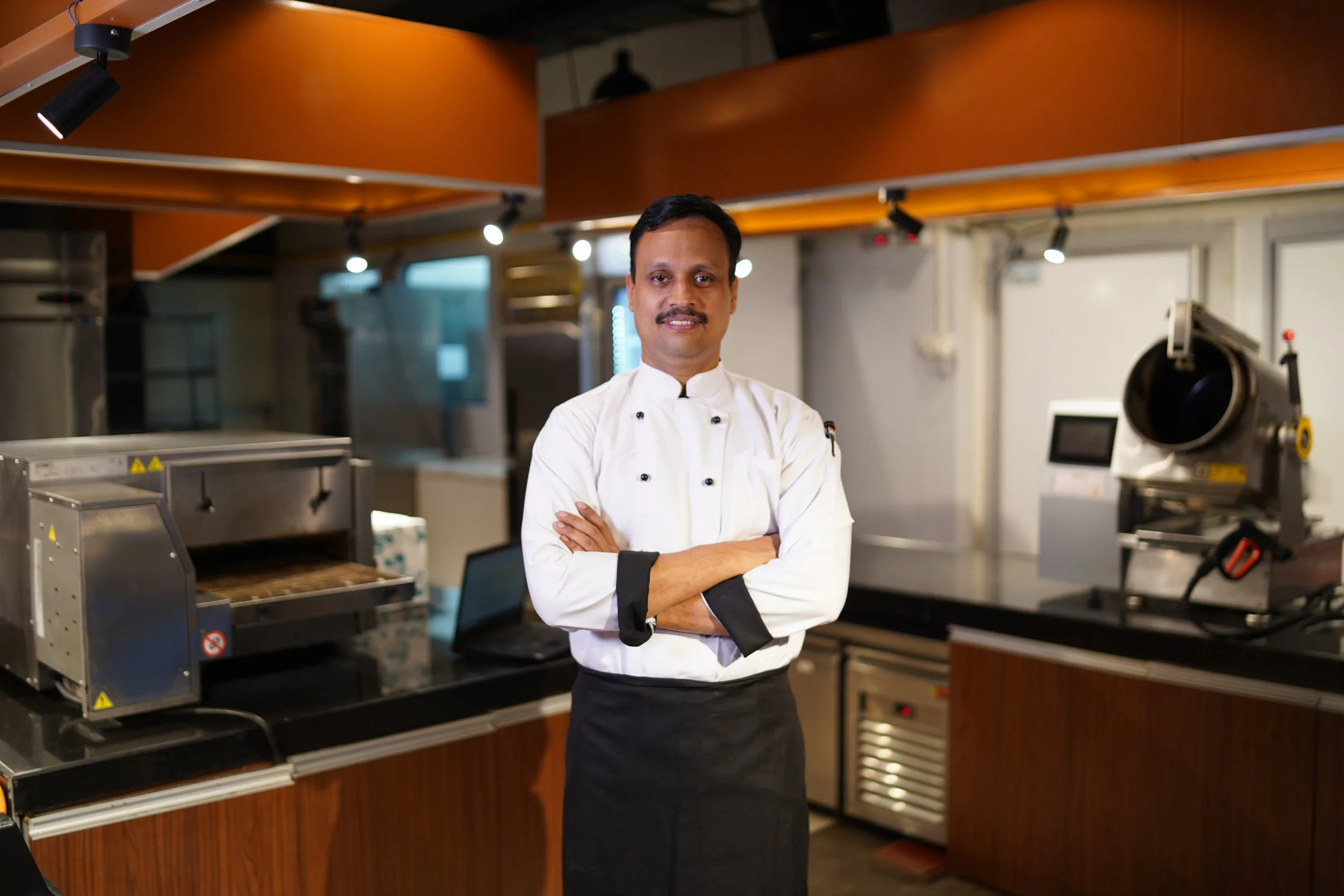Exclusive Interview | Chef Vijay Pandey, Corporate Chef, Rebel Foods
/“Consumers demand personalized dining experiences, customization based on taste preferences, dietary habits, and convenience. Chefs must continuously adapt, fine-tune their skills, and create handcrafted, memorable gourmet flavors. The ability to balance innovation with consistency is key.”
What inspired your journey into the culinary world, and how did you transition into leading multi-brand menu transformations at Rebel Foods?
My culinary journey began during my college days when I started cooking for myself and sharing my dishes with others. The feedback and appreciation I received fueled my passion. From fried rice to pav bhaji, from kesari kheer to falooda, I found joy in crafting every recipe. Despite pursuing an accounting degree, my love for cooking only grew stronger. This passion led me to pursue a hospitality management course after graduation, setting the stage for my career in the culinary world.
My journey took me from renowned hotels like The Leela and Hyatt Regency to diverse culinary environments, including five-star hotels, flight kitchens, cruise lines, and European restaurant chains in India. Each experience enriched my understanding of food formats, enabling me to experiment and innovate. Eventually, this diverse exposure helped me pioneer the cloud kitchen model at Rebel Foods, bringing multiple brands under one roof and revolutionizing the food industry.
With over a decade in the industry, what have been the biggest shifts in consumer dining preferences, and how do you adapt to them?
With 25 years in the industry, I’ve witnessed constant evolution in consumer preferences. The way people order, their awareness of global cuisines, and the influence of social media have significantly shaped dining trends. Traditionally, chefs specialized in a particular cuisine, and recipes remained fixed based on their expertise.
However, today’s consumers demand personalized dining experiences, favoring customization based on taste preferences, dietary habits, and convenience. To stay ahead, chefs must continuously adapt, fine-tune their skills, and create handcrafted, memorable gourmet flavors. The ability to balance innovation with consistency is key to winning customers’ hearts in this dynamic industry.
How does Rebel Foods approach innovation in menu development across its diverse portfolio of brands?
Rebel Foods stays ahead of industry trends by leveraging its global presence, AI-driven insights, and consumer feedback from various platforms, including our own ecosystem and aggregator channels. We identify trending products, curate new recipes through specialized chefs, and ensure access to premium ingredients and state-of-the-art processes.
Our approach to innovation includes:
Extensive Research & Development: New dishes undergo multiple validation stages, including FGDs (Focus Group Discussions) and pilot testing in 5% of our network for 2–3 months before a full-scale rollout.
Seasonal & Event-Based Launches: Each brand has a scheduled launch plan aligned with festivals and key events.
Continuous Optimization: Existing product ratings are closely monitored, and recipes are refined based on feedback, ensuring we consistently deliver exceptional food experiences.
You’ve worked in restaurants, luxury hotels, cruise lines, and cloud kitchens. How does each setting influence menu design?
Understanding the core customer base is critical in menu design, as different settings cater to diverse expectations:
Restaurants: Frequent customers expect personalized service. Understanding their preferences and curating customized dishes can build strong loyalty.
Luxury Hotels: Guests anticipate a fine-dining experience with global flavors, served in a modern yet authentic manner.
Cruise Lines: Large-scale meal production (for up to 6,000 guests) requires precision, hygiene, and efficiency, given the short dining windows.
Cloud Kitchens: The biggest challenge is replicating dine-in quality despite 20–30 minutes of delivery time. With no immediate customer feedback, ensuring consistency is crucial. By tracking ratings, analyzing trends, and reverse-engineering recipes, we create food that retains its excellence upon delivery.
What role does technology play in shaping modern cloud kitchens, and how do you integrate data-driven insights into menu creation?
Technology is at the core of Rebel Foods’ operations, driving efficiency and innovation:
Menu Development: AI-driven insights identify menu gaps, emerging trends, and consumer preferences based on search data, order patterns, and social media.
Production Monitoring: Backend processes are tracked using scanners, barcoding, temperature sensors, and GPS tracking to ensure consistency.
Operational Excellence: AI-enabled CCTV, SWAT (Size, Weight, Appearance, Temperature) analysis, and traceability systems maintain high standards in food preparation and delivery.
Inventory & Forecasting: Predictive analytics optimize ingredient sourcing, minimize waste, and enhance operational efficiency.
Sustainability is becoming a key focus in foodservice. How do you incorporate sustainable sourcing and waste reduction into menu planning?
At Rebel Foods, sustainability is a priority:
Ingredient Sourcing: We avoid artificial colors, synthetic additives, and antibiotic-laden meats, ensuring wholesome, natural food.
Packaging: As delivery-based dining grows, reducing plastic waste is crucial. While 95% of industry packaging is plastic, we are actively exploring compostable alternatives.
Renewable Energy: We have piloted solar energy initiatives to cut carbon emissions.
Eco-Friendly Delivery: Increasing adoption of electric scooters for order fulfillment aligns with our sustainability goals.
What are the biggest challenges in running a large-scale cloud kitchen operation, and how do you ensure quality and consistency?
The primary challenges include sourcing high-quality ingredients year-round, maintaining hygiene, and eliminating variability in food preparation. Our approach to consistency includes:
Farm-to-Fork Traceability: Each ingredient and dish is mapped, ensuring accountability at every stage.
Standardized Processes: Each Rebel Foods kitchen follows strict SOPs, with automated monitoring to eliminate human bias.
Batch Tracking & Quality Control: Unique kitchen codes enable swift recalls if any batch falls below quality standards.
Continuous Improvement: Customer ratings, feedback, and trend analysis help refine recipes for long-term excellence.
You’ve led kitchens at renowned brands like Manchester United Café Bar and Oakwood Premier. How did those experiences shape your leadership style?
At Oakwood Premier, the focus was on delivering exceptional Indian and international cuisine while personalizing dishes based on customer feedback. At Manchester United Café Bar, standardization was key across eight restaurants to ensure consistent quality.
In contrast, Rebel Foods operates at a much larger scale—350 kitchens—where recipes must be executed flawlessly without relying on individual chef skills. Standard operating procedures (SOPs), AI-driven monitoring, and real-time customer feedback play a critical role in maintaining consistency and evolving the menu continuously.
With international experience at Royal Caribbean, how have global culinary influences shaped your approach to menu development in India?
My global experience has influenced several key initiatives at Rebel Foods:
Michelin-Star Collaborations: Worked with Chef Vineet Bhatia on launching a contemporary Indian restaurant.
Diverse Cuisine Expansions: Introduced Lebanese cuisine at Manchester United Café Bar, transitioning a falafel QSR into a full-fledged Lebanese restaurant.
Brand Innovations at Rebel Foods: Spearheaded the launch of Firangi Bake, Ovenstory, Sweet Truth, and Faasos’ expanded burger wraps. Additionally, Wendy’s India introduced new flavors like chimichurri, cheese blast, and Korean-inspired burgers.
Looking ahead, what are your future goals, and how do you see the cloud kitchen model evolving in the next five years?
The cloud kitchen industry is growing at a CAGR of 30% annually, driven by convenience, time savings, and private dining trends. However, long-term success will depend on:
Brand Differentiation: Only those ensuring hygiene, quality, and consistency will thrive.
Faster Dispatch & Delivery: Optimized logistics will ensure food reaches customers within 15 minutes without compromising quality.
Technological Advancements: AI and automation will enhance operational efficiency and customer experience.
Culinary Innovation: The future belongs to brands that create exceptionally tasty, well-thought, and delightful food experiences.






